-
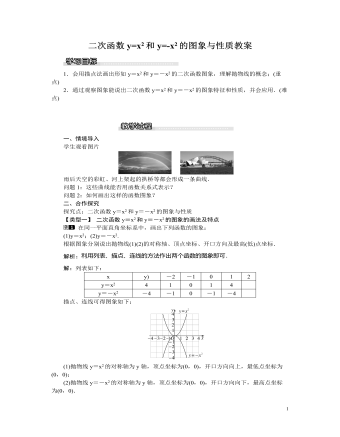
北师大初中九年级数学下册二次函数y=x2和y=-x2的图象与性质1教案
雨后天空的彩虹、河上架起的拱桥等都会形成一条曲线.问题1:这些曲线能否用函数关系式表示?问题2:如何画出这样的函数图象?二、合作探究探究点:二次函数y=x2和y=-x2的图象与性质【类型一】 二次函数y=x2和y=-x2的图象的画法及特点在同一平面直角坐标系中,画出下列函数的图象:(1)y=x2;(2)y=-x2.根据图象分别说出抛物线(1)(2)的对称轴、顶点坐标、开口方向及最高(低)点坐标.解析:利用列表、描点、连线的方法作出两个函数的图象即可.解:列表如下:x y) -2 -1 0 1 2y=x2 4 1 0 1 4 y=-x2 -4 -1 0 -1 -4 描点、连线可得图象如下:(1)抛物线y=x2的对称轴为y轴,顶点坐标为(0,0),开口方向向上,最低点坐标为(0,0);(2)抛物线y=-x2的对称轴为y轴,顶点坐标为(0,0),开口方向向下,最高点坐标为(0,0).方法总结:画抛物线y=x2和y=-x2的图象时,还可以根据它的对称性,先用描点法描出抛物线的一侧,再利用对称性画另一侧.
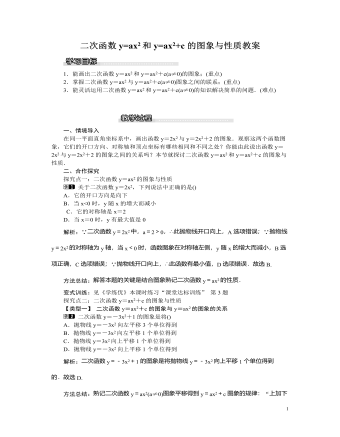
北师大初中九年级数学下册二次函数y=ax2和y=ax2+c的图象与性质1教案
变式训练:见《学练优》本课时练习“课堂达标训练”第5题【类型二】 在同一坐标系中判断二次函数和一次函数的图象在同一直角坐标系中,一次函数y=ax+c和二次函数y=ax2+c的图象大致为()解析:∵一次函数和二次函数都经过y轴上的点(0,c),∴两个函数图象交于y轴上的同一点,故B选项错误;当a>0时,二次函数的图象开口向上,一次函数的图象从左向右上升,故C选项错误;当a<0时,二次函数的图象开口向下,一次函数的图象从左向右下降,故A选项错误,D选项正确.故选D.方法总结:熟记一次函数y=kx+b在不同情况下所在的象限,以及熟练掌握二次函数的有关性质(开口方向、对称轴、顶点坐标等)是解决问题的关键.变式训练:见《学练优》本课时练习“课后巩固提升” 第4题【类型三】 二次函数y=ax2+c的图象与三角形的综合
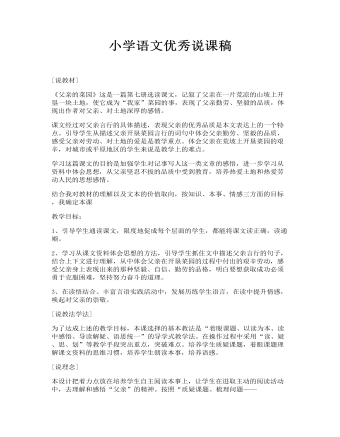
小学语文优秀说课稿 (优选10篇)
教学目标:1、引导学生通读课文,限度地促成每个层面的学生,都能将课文读正确,读通顺。2、学习从课文资料体会思想的方法,引导学生抓住文中描述父亲言行的句子,结合上下文进行理解,从中体会父亲在开垦菜园的过程中付出的艰辛劳动,感受父亲身上表现出来的那种坚毅、自信、勤劳的品格,明白要想获取成功必须勇于克服困难,坚持努力奋斗的道理。3、在读悟结合、丰富言语实践活动中,发展历练学生语言,在读中提升情感,唤起对父亲的崇敬。[说教法学法]为了达成上述的教学目标,本课选择的基本教法是“着眼课题、以读为本、读中感悟、导读解疑、语思统一”的导学式教学法。在操作过程中采用“读、疑、思、划”等教学手段突出重点,突破难点。培养学生质疑课题,着眼课题理解课文资料的思维习惯,培养学生朗读本事,培养语感。
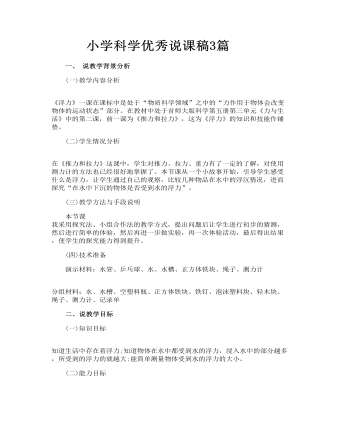
小学科学优秀说课稿3篇
(二)学生情况分析 在《推力和拉力》这课中,学生对推力、拉力、重力有了一定的了解,对使用测力计的方法也已经很好地掌握了。本节课从一个小故事开始,引导学生感受什么是浮力,让学生通过自己的观察,比较几种物品在水中的浮沉情况,进而探究“在水中下沉的物体是否受到水的浮力”。 (三)教学方法与手段说明 本节课 我采用探究法、小组合作法的教学方式,提出问题后让学生进行初步的猜测,然后进行简单的体验,然后再进一步做实验,再一次体验活动,最后得出结果,使学生的探究能力得到提升。 (四)技术准备 演示材料:水管、乒乓球、水、水槽、正方体铁块、绳子、测力计 分组材料:水、水槽、空塑料瓶、正方体铁块、铁钉、泡沫塑料块、轻木块、绳子、测力计、记录单
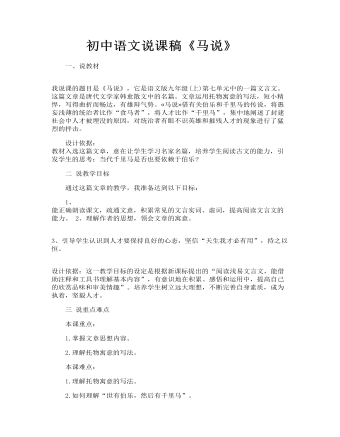
初中语文说课稿《马说》
二 说教学目标 通过这篇文章的教学,我准备达到以下目标: 1、 能正确朗读课文,疏通文意,积累常见的文言实词、虚词,提高阅读文言文的能力。 2、理解作者的思想,领会文章的寓意。 3、引导学生认识到人才要保持良好的心态,坚信“天生我才必有用”,持之以恒。 设计依据:这一教学目标的设定是根据新课标提出的“阅读浅易文言文,能借助注释和工具书理解基本内容”,有意识地在积累、感悟和运用中,提高自己的欣赏品味和审美情趣”。培养学生树立远大理想,不断完善自身素质,成为执着,坚毅人才。 三 说重点难点 本课重点: 1.掌握文章思想内容。 2.理解托物寓意的写法。 本课难点: 1.理解托物寓意的写法。 2.如何理解“世有伯乐,然后有千里马”。 四 说教法学法: 教法:诵读法、引导法。 学法: 自主、合作、探究式学习。 设计依据:诵读法是学习文言文的基本方法。同时,在课堂教学中,必须贯彻以学生为主体和教师为主导的教学原则,教师应引导并组织学生进行自主、合作、探究式的学习。
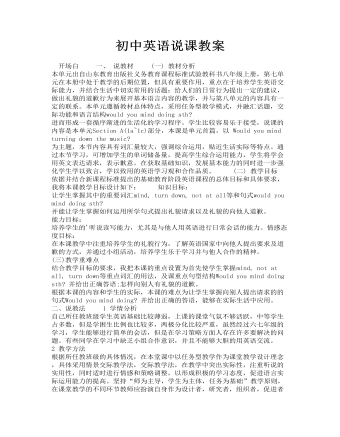
初中英语说课教案
(二) 教学目标 依据并结合新课程标准提出的基础教育阶段英语课程的总体目标和具体要求,我将本课教学目标设计如下: 知识目标: 让学生掌握其中的重要词汇mind, turn down, not at all等和句式would you mind doing sth? 并能让学生掌握如何运用所学句式提出礼貌请求以及礼貌的向他人道歉。
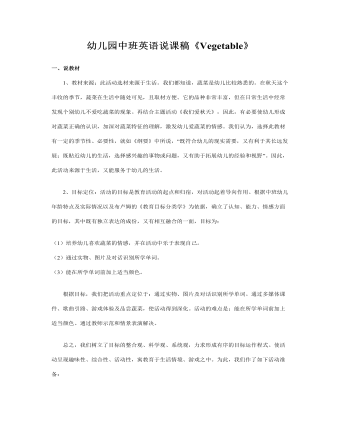
幼儿园中班英语说课稿《Vegetable》
2、目标定位:活动的目标是教育活动的起点和归宿,对活动起着导向作用。根据中班幼儿年龄特点及实际情况以及布卢姆的《教育目标分类学》为依据,确立了认知、能力、情感方面的目标,其中既有独立表达的成份,又有相互融合的一面,目标为:(1)培养幼儿喜欢蔬菜的情感,并在活动中乐于表现自己。 (2)通过实物、图片及对话识别所学单词。(3)能在所学单词前加上适当颜色。 根据目标,我们把活动重点定位于:通过实物、图片及对话识别所学单词。通过多媒体课件、歌曲引路、游戏体验及品尝蔬菜,使活动得到深化。活动的难点是:能在所学单词前加上适当颜色。通过教师示范和情景表演解决。 总之,我们树立了目标的整合观、科学观、系统观,力求形成有序的目标运作程式。使活动呈现趣味性、综合性、活动性,寓教育于生活情境、游戏之中。为此,我们作了如下活动准备:1、空间准备:把幼儿围成半圆形,操作台放于侧面。 2、物质准备:小熊毛绒玩具、创编歌曲、多媒体课件、各种蔬菜(如西红柿tomato、萝卜carrot、黄瓜cucumber、韭菜leek等)。3、经验准备:幼儿已经认识多种颜色,并对蔬菜有一定的经验(吃过或看过)。
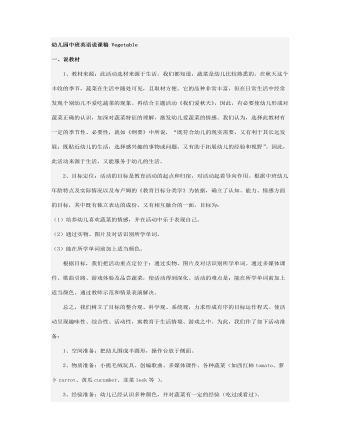
幼儿园中班英语说课稿 Vegetable
教材来源:此活动选材来源于生活。我们都知道,蔬菜是幼儿比较熟悉的。在秋天这个丰收的季节,蔬菜在生活中随处可见,且取材方便。它的品种非常丰富,但在日常生活中经常发现个别幼儿不爱吃蔬菜的现象。再结合主题活动《我们爱秋天》,因此,有必要使幼儿形成对蔬菜正确的认识,加深对蔬菜特征的理解,激发幼儿爱蔬菜的情感。我们认为,选择此教材有一定的季节性、必要性,就如《纲要》中所说,“既符合幼儿的现实需要,又有利于其长远发展;既贴近幼儿的生活,选择感兴趣的事物或问题,又有助于拓展幼儿的经验和视野”。因此,此活动来源于生活,又能服务于幼儿的生活。
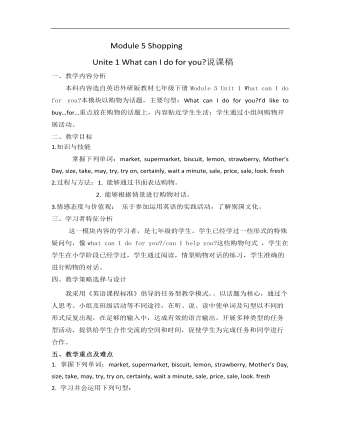
初中英语外研版七年级下册《Module 5 Shopping》说课稿
二、教学目标1.知识与技能掌握下列单词:market, supermarket,biscuit, lemon, strawberry, Mother’s Day, size, take, may, try, try on,certainly, wait a minute, sale, price, sale, look. fresh2.过程与方法:1. 能够通过书面表达购物。2. 能够根据情景进行购物对话。3.情感态度与价值观:乐于参加运用英语的实践活动,了解别国文化。
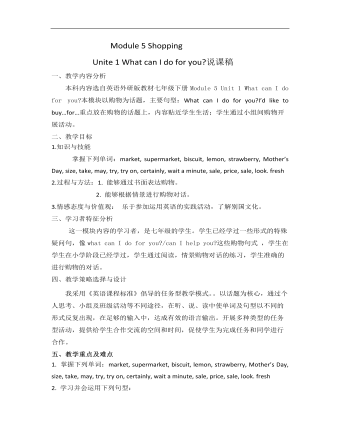
初中英语外研版七年级下册《Module 5 Shopping》说课稿
二、教学目标1.知识与技能掌握下列单词:market, supermarket,biscuit, lemon, strawberry, Mother’s Day, size, take, may, try, try on,certainly, wait a minute, sale, price, sale, look. fresh2.过程与方法:1. 能够通过书面表达购物。2. 能够根据情景进行购物对话。3.情感态度与价值观:乐于参加运用英语的实践活动,了解别国文化。三、学习者特征分析这一模块内容的学习者,是七年级的学生。学生已经学过一些形式的特殊疑问句,像what can I do for you?/can I help you?这些购物句式 ,学生在学生在小学阶段已经学过,学生通过阅读,情景购物对话的练习,学生准确的进行购物的对话。
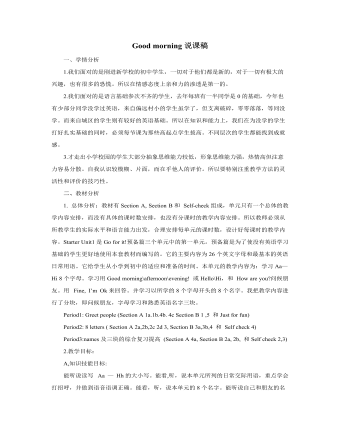
人教版新目标初中英语七年级上册Good morning说课稿
1.课堂活动中的竞赛制:以记奖评优的形式无声的评价每一个活动,包括个体和小群体。在第一课时评最佳演员和导演奖,第二课时评最佳团体奖,既节约时间又明确有效。使学生能提高语言质量,增强参与意识,提高学习兴趣。2. 教师课堂上语言、表情激励制:在课堂活动中教师要乐于 、善于用激励性语言。从good, super, smart, excellent , great ,wonderful等,用微笑,皱眉,摇头、点头等身体语言对于学生的评价是方便又有效的途径。3.课后作业评价:口头作业在第二天课堂上表演,接受全体同学的评价。笔头作业有教师批阅,以评语的方式出现。优秀作业予以展出或交流。积极地肯定和鼓励学生是我们评价的重要目的之一。4.单元结束后综合性评价:除了笔试以外,也可以根据学生实际开展丰富的活动,如:调查报告、小品表演、专题演讲等。
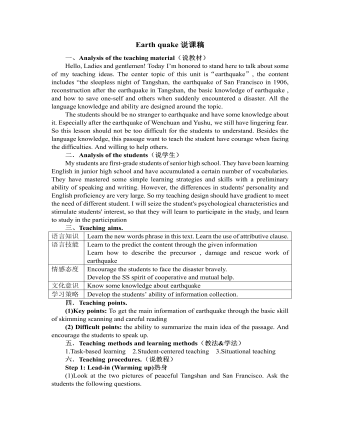
人教版高中英语必修1Earth quake说课稿
(4)Finally, I will ask the SS what this sentence mean:It is always calm before a storm.Purpose: attract the SS attention and bring them into discussionStep 2: Pre-reading 读前Here, I will do the second question in pre-reading first. I will use the method of brainstorming to ask the SS what will happen before an earthquake; and list the phenomenon on the table. 2. Then I will show the SS the picture of abnormal phenomenon, at the same time, encourage the SS to describe.3、finally, I will summarize these phenomenon4、Do the first question in the pre-reading , Imaging your home begins to shake and you must leave it right away. You have time to take only one thing. What will you take? Why?Purpose: help the SS to get further understanding of the topic and stimulate their interests.Step3: While-reading 阅读(1). Skimming Read the text quickly and catch the meaning of the first and second sentence of each paragraph. Predict the meaning of new words(2).scanning(找读)A. Read the text again. Do the following question.1. When and where were the strange things happening?2. What are they?3. Why did the text say the world seemed to be at an end?4. How was the city destroyed after the quake?5. When did the second quake hit the city? What was the result of that?6. Who came to help Tangshan first? And how?B. Work in pairs to discuss the question.
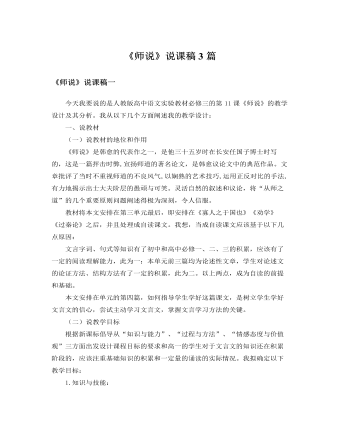
人教版高中语文必修3《师说》说课稿3篇
一、设计理念教学设计坚持少讲多学、以学为主的教学理念,重视学培养生的学习兴趣,要充分调动学生学习的积极性和主动性,充分发挥学生的主体性。教师要以组织者、引导者、合作者的角色参与到教学活动中去。力图通过导学案努力培养学生的自学习惯和自学能力。二、教材分析与处理1、教材的地位与作用:必修三第三单元所选的文言文都是古代的议论性散文。本课是“唐宋八大家”之首、中唐古文运动的倡导者韩愈的力作,是唐宋散文中的名篇,具有很强的代表性。通过这篇自读课的学习,能使学生了解唐宋散文的风貌,更能使学生进一步积累文言文基础知识,提高学生的文言文阅读欣赏能力,从而提升学生的文言文自读能力。2、教学目标:《高中语文课程标准》要求高中学生能阅读浅易文言文,能借助注释和工具书,理解词句含义,读懂文章内容;了解并梳理常见的文言实词、文言虚词、文言句式的意义或用法,注重在阅读实践中举一反三;对文章有一定的分析欣赏能力。高一的学生对于文言文的知识还在积累阶段,应该注重基础知识的积累和一定量的诵读。对此,我将教学目标确定为:
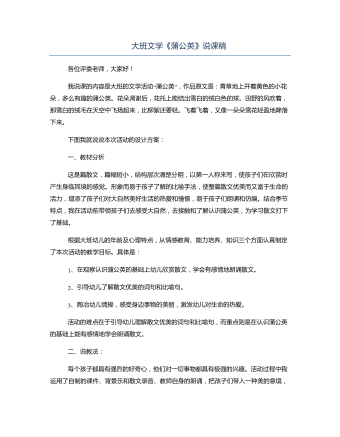
大班文学《蒲公英》说课稿
一、教材分析这是篇散文,篇幅短小,结构层次清楚分明,以第一人称来写,使孩子们在欣赏时产生身临其境的感觉。形象而易于孩子了解的比喻手法,使整篇散文优美而又富于生命的活力,增添了孩子们对大自然美好生活的热爱和憧憬,易于孩子们朗诵和仿编。结合季节特点,我在活动前带领孩子们去感受大自然,去接触和了解认识蒲公英,为学习散文打下了基础。根据大班幼儿的年龄及心理特点,从情感教育、能力培养、知识三个方面认真制定了本次活动的教学目标。具体是:1、在观察认识蒲公英的基础上幼儿欣赏散文,学会有感情地朗诵散文。2、引导幼儿了解散文优美的词句和比喻句。3、陶冶幼儿情操,感受身边事物的美丽,激发幼儿对生命的热爱。活动的难点在于引导幼儿理解散文优美的词句和比喻句,而重点则是在认识蒲公英的基础上能有感情地学会朗诵散文。二、说教法:每个孩子都具有强烈的好奇心,他们对一切事物都具有极强的兴趣。活动过程中我运用了自制的课件、背景乐和散文录音、教师自身的朗诵,把孩子们带入一种美的意境,使孩子们在优美的意境中感受了散文的语言美,体验学习散文的快乐。活动的开展由易到难,层层深入,使孩子们能主动积极、自愿地参与和学习,获得经验,体验了孩子的主体地位,也正好契合了《纲要》中关于“教师应成为幼儿学习活动的支持者、合作者、引导者”的理念。此外我还采用了欣赏倾听法、谈话交流法、游戏表演法引导孩子在活动中敢说、想说、愿意说,树立了孩子的自信心,从而使本次活动达到美的享受,快乐学习的和谐统一。

对初中英语教师说课技能的思考与建议
一、认识说课的实质说课是指教师以现代教育理念为指导,在精心备课的基础上,面对同行或教学研究人员,采用口头语言或相关辅助手段,阐述某学科课程或某具体课程的教学设计及其依据的教学研究过程(李崇爱,孟应周,2011)。简单而言,说课就是教师对“教什么”、“怎么教”、“为什么这么教”等问题进行阐述。这样做的目的,一方面可以展现一个教师的教育理论修养、教学组织能力和口头表达能力,另一方面可以帮助教师优化教学设计,反思教学行为,分享教学经验。
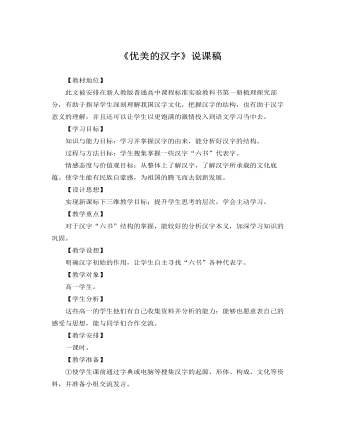
人教版高中语文必修1《优美的汉字》说课稿
明确:(1)结绳记事说。原始记事的一种方法。人类在没有发明文字或文字使用尚不普遍时,常用在绳索或类似物件上打结的方法记录数字,表达某种意思,用以传达信息,处理事件。 (2)书画说。(3)仓颉造字说。中国自古就有仓颉造字之说。文字的发明是人类发展史上一件石破天惊的大事,它将人们的思维、语言、经验以及复杂的社会现象记录下来,使文化得以传播交流、世代传承。2、汉字的形体:中华民族五千年的历史中,汉字的演变,从甲骨文--金文--大篆--小篆--隶书--草书--楷书--行书,字形由象形到点横竖撇捺的方块字,经历了漫长的岁月。其中凝聚着民族的智慧,也体现出汉字逐步完善的过程,凸显其方方正正、四平八稳的特点。汉字又是一种文化的体现,那些经过艺术处理的汉字或跳起了拉丁舞、有的如同酒醉的成龙打起了醉拳,更是让我们感到的是在欣赏汉字在纸张上跳舞,所以:书法是“纸上的舞蹈”。请大家看到书上的相关内容,注意每一种形体的汉字的载体是什么,其功能又有什么不一样。

人教版高中英语必修1Journey Down the Mekong说课稿
2. let the Ss complete the forms paragraph by paragraph. Purpose here is to help Ss to get the habit of reading a passage as a whole, and pay attention to the organization of the text, as a result the Ss will fully understand the whole passage.3. ask Ss to retell the passage with the help of the key words in the form.Since the Ss in the class are in different levels, so I let them to fill in the blank to understand the meaning of the words and phrases better. ( That’s all for the while-reading. Now let’s move to the fifth step.)Step V: Post-reading (10mins) ---DiscussionIn this part students are asked to discuss in groups and list Wang Kun’s and Wang Wei’s attitudes about the trip. After that, Ss are encouraged to express their attitudes with the whole class. Collect their answers and don’t forget to praise them even if their answers may not be perfect.In this activity, discussion provides a vivid and active learning environment for Ss to communicate in English with newly learned language items. (Finally it comes to the homework.)StepⅥ: Homework (1min)1. Ss are required to read the text again after class and figure out the meaning of some complex sentences.2. Do the exercises on P19; This can help Ss to consolidate what they’ve learnt and make preparation for the next lessonPart4. Blackboard design.(说板书设计)On the top, there is the title of this lesson. On the left, there are main ideas for each paragraph. On the right, there are some new words and expressions.Unit 3 Travel journalJourney down the MekongMain idea of each para.:Para1: deciding to take a great bike trip along the Mekong river.Para2: Different attitudes between Wang kun and Wang wei.

人教版高中英语必修4Body Language说课稿4篇
Textbook: Senior English for China (Book 4), by Liu Daoyi Time Allotment: 1 period (40 minutes)Date: March 20, 2014Teaching aids: blackboard, Multi-media, Power Point, chalk I. Text Analysis (教材分析)This unit is about body language, and the text selected in the reading part demonstrates the difference and similarity of body language in many parts of the world. Through learning this passage, students are required to raise their awareness of using body language in different parts of the world. As body language is closely related to our daily life, it is easy to arouse students’ interest in learning this text. Reading skills and speaking training are designed around the text.II. Teaching Objectives (教学目标)By the end of the lesson, students will be able to:1. Language Skill Objective(语言技能目标): develop reading ability (skimming and scanning)as well as speaking ability.2. Cultural Knowledge Objective(文化知识目标): know about the cultural differences of using body language.3. Affective Objective(情感目标): increase students’ awareness of using body language correctly in different cultures. III.Teaching Focuses and Difficulties(教学重点和难点)1. Teaching Focuses(教学重点): the difference and similarity of body language in many parts of the world.2. Teaching Difficulties(教学难点): develop students’ reading abilities of skimming and scanning and ask the students to show their opinions with fluent English.

人教版高中英语必修1Anne's best friend说课稿
Step 7 Language points 1.Vocabulary (1) go through (2) set down (3) a series of (4) on purpose (5) in order to (6)at dusk (7)entirely (8)face to face 2.Important sentences (1)…I’ve grown so crazy about everything to do with nature. (2)There was a time when … (3)I stayed awake on purpose until … (4)It was the first time … that I’d seen the night … (5)It’s no pleasure looking through … Purpose: 1.Master the required vocabulary and sentence structures. 2.Use them freely. Step 8 Consolidation 1.Find out the topic sentences 2.Retell the text according to the topic sentences Purpose: I want to know if my students understand the text. Step 9 Discussion Imagine you have to go into hiding like Anne and her family, what would you miss most? Giveyour reasons. Purpose: Train Ss’ oral English ability. Step 10 Homework Write an article on Friends. Purpose: 1. Improve the Ss’ writing ability. 2 Train the Ss’ ability of self—teaching and looking up information by themselves. Part 5 Blackboard design(说板书设计)Unit 1 Friendship Reading Anne’s Best Friend 1.Main idea of each paragraph: Para. 1 Anne made her diary her best friend. Para .2 Anne wrote her feelings in her diary. Para .3 Anne missed nature. Para.4 Anne saw the night face to face Para.5 Anne wanted to experience nature outdoors. 2.Listening: Exx.1 P3 3.Discussion: Exx.3 P3 Purpose: 1.Make Ss familiar with the passage 2.Make the design inductive, instructive and artistic.

人教版高中英语必修1English around the world说课稿
(3)v. 给:提出;展现,显现present sb. with sth. ; present sth. to sb. 把. . 交给;颁发;授予present sth. (for sth. )/present sth. to sb. e. g. Om his birthday, his friends presented him a collection of stamps. 在他生日时,他的朋友们送给他一套邮票作为礼物。The sword was presented by the family to the museum. 这家人把宝剑捐赠给了博物馆。The committee will present the final report to Parliament in June. 委员会将在六月向议会提交最后的报告。You need to present yourself better. 你需要更善于展现自己。It is essential that we present a united front. 至关重要的是我们要表现得更加团结。Step 4 ConsolidationT:Now that we have got a general idea of these words and phrases. Lets make up some sentences using them to master them. Suggested sentences:1. Your duties include typing letters and answering the telephone. 2. It is one of the greatest roles that she has played. 3. A large number of people have applied for the job. 4. The number of the panda is declining. 5. I'11 go there, even if I have to walk. 6. He came up to me to ask for a light. 7. The novel is about a family who can't communicate with each other. 8. He based his plan on interests of most people. 9. Why doesn't he make use of his singing talent?Step 5 Summary and homeworkT:Today we dealt with several new words and phrases. After class I hope that youcan read them again and again to keep them in mind. That's all for today. You aredismissed.